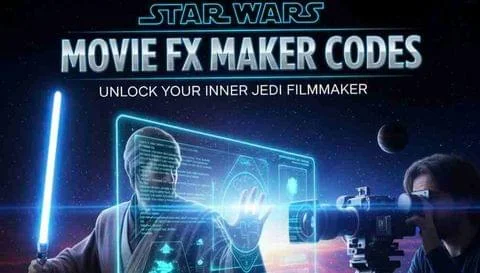Key Takeaways of Star Wars movie FX Maker Codes
| Aspect | Description |
|---|---|
| Focus | Discovering the FX Maker codes used in creating Star Wars movie effects. |
| Core Entities | Lucasfilm, Industrial Light & Magic (ILM), George Lucas, Adobe After Effects, Blender, Unreal Engine. |
| Purpose | To show how digital artists use FX Maker codes to replicate Star Wars-style visuals. |
| Impact | Unlocking creative techniques that shaped the sci-fi visual era. |
The Birth of Star Wars movie FX Maker Codes
| Era | Major Innovation |
|---|---|
| 1977 – A New Hope | Industrial Light & Magic introduced motion control cameras. |
| 1999 – The Phantom Menace | Digital compositing and CGI transformed galactic battles. |
| 2015 – The Force Awakens | ILM integrated Unreal Engine for real-time effects. |
When George Lucas founded Lucasfilm in 1971, no one imagined that Star Wars would become a blueprint for visual effects innovation. Using custom FX Maker codes, engineers and artists at Industrial Light & Magic (ILM) created seamless integrations of miniatures, light effects, and digital compositing.
By the time The Force Awakens hit theaters, FX Maker pipelines combined AI simulation, 3D rendering, and color mapping algorithms. These codes became the DNA of modern VFX production — enabling fans and filmmakers to recreate iconic lightsaber duels, space battles, and force projections with remarkable realism.
Core Highlights of Star Wars movie FX Maker Codes
- ILM built the world’s first digital motion-control system, the Dykstraflex.
- FX Maker scripts later evolved into plug-ins for tools like Adobe After Effects.
- Modern recreations use Unreal Engine 5 and AI particle simulators.
Inside the FX Maker Code System
| Component | Function |
|---|---|
| Render Core | Handles ray tracing and global illumination in space scenes. |
| Shader Scripts | Define how light interacts with surfaces like droids or ships. |
| Particle Systems | Control explosions, plasma trails, and debris fields. |
The term “Star Wars movie FX Maker Codes” refers to specialized VFX scripts that automate complex rendering processes. These codes, originally written in C++, Python, and later MEL (Maya Embedded Language), made ILM’s workflow faster and more scalable.
When John Knoll, a senior VFX supervisor and co-creator of Adobe Photoshop, worked on Episode I, he introduced modular FX systems that became industry standards. These FX Maker codes allowed animators to reuse lighting, lens flares, and dust simulations — drastically cutting production time.
Key Concepts
- Python scripting is central to Blender and Maya FX automation.
- Node-based compositing lets artists replicate Star Wars hyperspace jumps.
- Publicly shared FX Maker plug-ins on GitHub help fans recreate lightsaber glow codes.
Recreating Star Wars at Home
| Tool | Use Case |
|---|---|
| Adobe After Effects | Apply color keying, blaster bolts, and lightsaber glow codes. |
| Blender | Use particle FX to simulate star explosions and ship battles. |
| Unreal Engine | Render cinematic sequences with real-time lighting. |
You don’t need a Hollywood studio to make your own Star Wars FX. Using the same logic as ILM’s proprietary codes, fans now use FX Maker scripts and plug-ins to reproduce the movie’s iconic visuals.
For example, a lightsaber effect can be built using a glow mask layer, Gaussian blur, and keyframe intensity coding in After Effects. Similarly, explosion FX codes in Blender rely on particle emitters with random velocity matrices.
DIY FX Tips
- Use color LUTs inspired by The Mandalorian for cinematic tones.
- Combine AI rotoscoping tools like Runway ML for clean keying.
- Apply Star Wars code presets from FXHome for faster workflows.
Lucasfilm’s Secret Sauce: ILM’s Proprietary Tech
| Technology | Application |
|---|---|
| Zeno Engine | ILM’s proprietary 3D animation and physics engine. |
| StageCraft (The Volume) | LED-wall environment tech used in The Mandalorian. |
| NukeX Pipelines | Node compositing for multi-layered space shots. |
Industrial Light & Magic (ILM) has always been at the forefront of FX innovation. Their in-house Zeno engine laid the foundation for today’s 3D physics simulations, while StageCraft redefined how virtual production works.
Instead of green screens, The Mandalorian used real-time 3D backgrounds rendered through Unreal Engine. This made lighting realistic and cut post-production time. Each component of ILM’s pipeline is built on custom Star Wars movie FX Maker Codes, linking physics simulation, texture mapping, and real-time rendering.
Core Insights
- Zeno blends physical simulation with procedural animation.
- StageCraft uses 4K LED panels linked to motion tracking cameras.
- NukeX scripting automates lens distortion and cosmic compositing.
The Digital Legacy of George Lucas
| Year | Innovation |
|---|---|
| 1977 | Created ILM to achieve impossible space visuals. |
| 1991 | Launched THX Sound System for immersive audio design. |
| 2012 | Sold Lucasfilm to The Walt Disney Company for $4.05B. |
George Lucas didn’t just make movies—he redefined technology in storytelling. His creation of ILM, THX, and Skywalker Sound turned cinema into a testbed for software development.
Today, filmmakers still use code derivatives inspired by Lucas’s early motion-tracking FX systems. These systems evolved into modern tools like Nuke, RenderMan, and Unity VFX Graph. Star Wars movie FX Maker Codes.
Key Highlights
- Lucas’s push for innovation birthed digital filmmaking.
- His R&D team’s FX codes became open-source templates for studios.
- ILM’s archives continue to train AI-based VFX generators.
Modern Fan Projects and Open FX Codes
| Platform | Project Example |
|---|---|
| GitHub | “Jedi-GlowFX” and “SpaceWarp Scripts” replicate ILM-style flares. |
| FXHome Community | Fan-built lightsaber plug-ins for free. |
| Reddit /r/StarWarsVFX | Coders share open-source shaders and explosion nodes. |
The fan-driven innovation behind Star Wars FX Maker codes is remarkable. Communities on GitHub, FXHome, and Reddit share re-creations of ILM-style plug-ins — turning once-secret codes into open creative tools.
Developers now use machine learning algorithms to simulate the “Force Push” wave distortion, while AI models replicate Star Destroyer lighting behavior. OpenFX standards have democratized the power once held by Hollywood studios.
Fan Takeaways
- Open-source FX keeps Star Wars visual legacy alive.
- Collaboration bridges the gap between fans and professionals.
- Code literacy is the new creative superpower in filmmaking.
The Future of Star Wars FX Coding
| Trend | Direction |
|---|---|
| AI Integration | Generative algorithms to automate FX creation. |
| Virtual Production | Expanding StageCraft and metaverse filmmaking. |
| Interactive FX Codes | Real-time simulation for AR and VR storytelling. |
The next frontier for Star Wars FX is AI-powered filmmaking. Studios like ILM and Epic Games are developing procedural VFX codes that can simulate galactic environments instantly.
Machine learning tools like Runway ML, Kaiber AI, and NVIDIA Omniverse allow creators to render force fields, hyperspace, or droid movement physics with minimal human input. The future of FX is both automated and artistic, merging technical intelligence with cinematic emotion.
Read also ReaLifeCamù: When Life Becomes the Livestream
Future Insights
- AI coding assistants will become part of every FX pipeline.
- Star Wars FX Maker Codes will evolve into real-time cinematic engines.
- Creative storytelling will rely on code-driven imagination.
Final Reflection
The legacy of Star Wars isn’t just its story — it’s the technology that tells it. From ILM’s Zeno scripts to Unreal’s real-time FX codes, every innovation connects fans and creators through shared creativity.
These codes are more than tools; they’re the modern Force—invisible yet powerful. Whether you’re editing a short film or crafting a galaxy far, far away, remember: behind every lightsaber flicker is a line of code that changed cinema forever.



